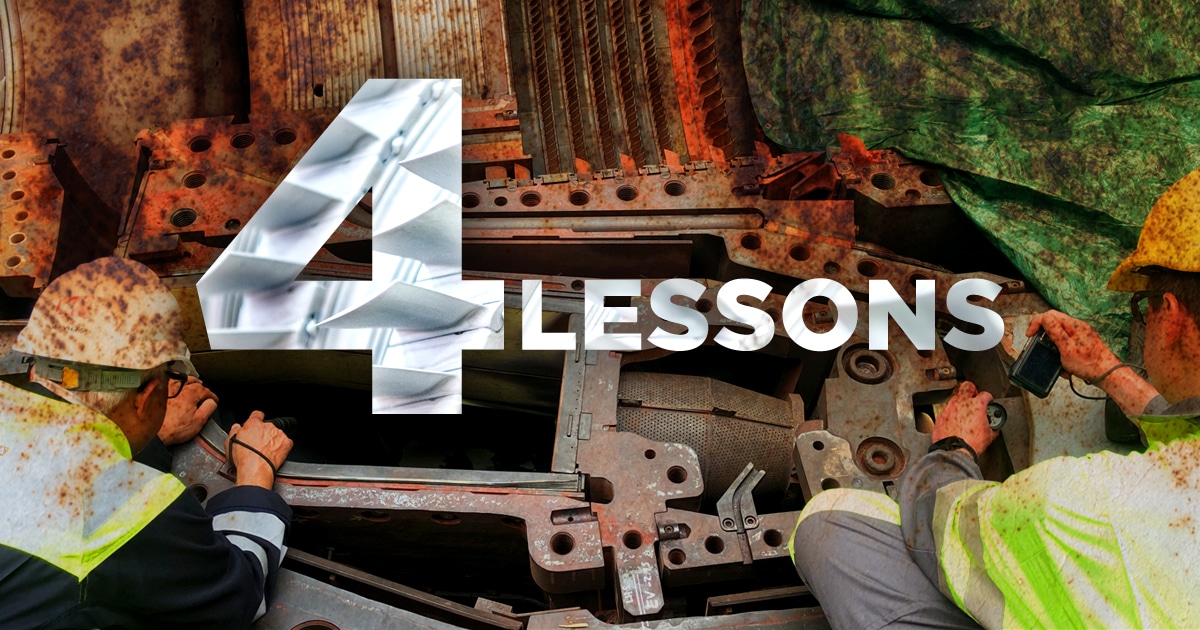Last year, one of my clients experienced an unplanned gas turbine outage that was, in a word, catastrophic.
It happened in May 2022 at Rocksavage Power Station, a combined cycle natural gas fired power plant in England, just southeast of Liverpool. We had just finished an inspection of the gas turbines four weeks earlier, and all had gone well — but then, late one evening, the high-temperature alarms began to sound. The turbine was shut down. A borescope inspection showed major damage to the turbine and revealed that the entire bottom half of the EV combustion section would have to be replaced. This was, to put it mildly, not good.
But the story has a happy ending. I worked with the Rocksavage team to devise a truly innovative and pragmatic solution that had never been tried before. As a result, we returned the plant to full operation in half the expected time.
It’s my hope that plant owners and operators can consider what we learned if they’re ever faced with a similarly challenging situation.
1. Ask yourself: What’s most important?
This may seem like an unnecessary question: The most important thing is to fix the problem, right? Well, first, you must dive a little deeper into your goals and limitations. Is it most important:
- To find a cost-effective solution?
- To devise a solution that’s future-proof — i.e. making a long-term investment in the plant?
- To identify a solution that can fix the problem quickly?
All of these factors were important to the Rocksavage team, but foremost in their minds was time. Because of prior commitments and a project backlog, the OEM estimated it would take 46 to 48 weeks to manufacture a replacement combustor. It would take several weeks or months more to schedule the resources needed to reassemble the gas turbine and get it back in operation — and that was if everything else went according to plan!
The Rocksavage team hoped to have the plant running at full capacity for the winter period to meet the high demand for power. Was there an alternative approach that would allow them to achieve this goal?
2. Collaboration produces inspiration.
The Rocksavage team is experienced and capable, but they knew it didn’t make sense to take on this enormous undertaking alone. First, they called me. I’ve worked with Rocksavage before, and my 24 years with Alstom Power enabled me to bring valuable insights to the GT assessment and identify the options.
That was only the first of many collaborations this particular challenge would require. In the process of seeking solutions for the Rocksavage GT outage, we reached out to companies in the Netherlands, Switzerland, the United States, and Argentina. If one contact determined they couldn’t help us, they pointed us to someone else who might be able to, and so we benefited from a chain of expertise that spanned the globe. Those of us who work in thermal power generation know that our industry is full of brilliant and creative people, with minds that relish an engineering challenge and generous spirits that are willing to help. Take advantage of this network!
3. There’s never just one answer to the question.
To repair the turbine, we knew the simplest course of action would be to order new parts from the OEM and wait. But my long career has taught me that the accepted, industry-standard solution isn’t always the best solution. So we searched for an alternative approach.
Through our research and collaboration, we learned that the Dock Sud power plant in Buenos Aires, Argentina, had in storage the exact Alstom GT26 components that we needed. It was a major breakthrough, but it was also a risk. I had never heard of a power plant repairing a gas turbine using original secondhand parts. Would these parts work? What if they were in poor conditions or didn’t have enough service life left?
We assembled a team of independent engineers along with the maintenance and reliability manager for Rocksavage. Together, they assessed the components and found them to be compatible with the Rocksavage GT and had enough service life left for immediate use .
We had found a workable, if non-standard, solution. And while we expected some stumbling blocks, we knew we had the expertise in our team to deal with problems as they arose.
4. Stay pragmatic.
“Pragmatic” is my favorite word. According to the Oxford dictionary, it means “dealing with things sensibly and realistically in a way that is based on practical rather than theoretical considerations.”
That’s exactly what we sought to do in the case of the Rocksavage gas turbine outage. At every step in the process, we asked ourselves: Which course of action makes sense to pursue, based on what we know? What’s the most likely outcome?
To me, pragmatism and innovation go hand in hand. Innovation means seeking out creative and novel solutions — pragmatism requires an honest assessment of the risks, a decisive course of action, and willingness to deal with the problems as they come. That’s just what we did at the Rocksavage Power Station, and thus we were able to return the plant to full operation in half the expected time.
Seeking a power industry consultant who takes a pragmatic approach to problem solving? Let’s connect.
See the article in POWER magazine: An Unplanned Outage, an Unconventional Plan, and a Global Collaboration
Get an in-depth look at the process: See our AOG Conference Presentation


